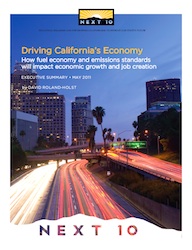Maybe a coincidence, but on the same day the EPA and DOE released new fuel economy labels, Next 10 released a new study, “Driving California’s Economy: How Fuel Economy and Emission Standards Will Impact Economic Growth and Job Creation.” The study found that policies that support fuel efficiency will drive consumer savings, drive job creation and spur economic growth. In addition, the study concluded that the highest passenger vehicle fuel economy and vehicle emissions standards produce the most positive results in terms of job creation, household savings, Gross State Product, and emissions reductions.
“Our study indicates that when it comes to fuel economy and emissions standards, Californians don’t have to choose between a robust economy and a cleaner vehicle fleet — they can enjoy both,” said Professor David Roland-Holst, author of the report.
 The report used an economic forecasting model to project the effects of improved fuel economy and emission standards both enacted by the federal government and under consideration by the state. When compared to California’s economic performance without any vehicle fuel economy or emissions standards, if fuel economy improved by 4-6 percent per year starting in 2017, California would see the following impacts by the year 2025: the addition of 38,000 to 236,000 jobs; an increase in GSP of .82 percent to 1.31 percent; and a reduction of 8 percent to 19 percent of state GHG emissions.
The report used an economic forecasting model to project the effects of improved fuel economy and emission standards both enacted by the federal government and under consideration by the state. When compared to California’s economic performance without any vehicle fuel economy or emissions standards, if fuel economy improved by 4-6 percent per year starting in 2017, California would see the following impacts by the year 2025: the addition of 38,000 to 236,000 jobs; an increase in GSP of .82 percent to 1.31 percent; and a reduction of 8 percent to 19 percent of state GHG emissions.
F. Noel Perry, founder of Next 10, said of the study, “For more than three decades, California’s investments in energy efficiency — through groundbreaking building, appliance, and utility regulatory standards — have reaped substantial economic returns for consumers in our state. These returns have in turn supported the creation of new jobs and businesses. Californians will see similar benefits when it comes to clean cars.”
Currently, the California Air Resources Board (CARB) is in the midst of passing legislation that will set vehicle emission standards for passenger cars sold in the state for model years 2017-2025. States are allowed under the federal Clean Air Act to set their own vehicle emission standards but not fuel economy standards – those can only be set by the federal government. Oftentimes other states follow California’s lead and today, 14 other states currently follow California’s emission policies. EPA and the National Highway Traffic Safety Administration are expected to announce the new fuel economy standards this fall.

